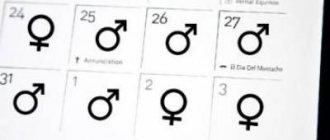Nowadays, future parents no longer have to guess the sex of the child. High-precision ultrasound examinations make it possible to determine who will be born to a couple in the early stages. But the blood types of the parents can “tell” a lot about the future baby.
A certain combination of groups gives some guarantee that a boy or a girl will be born. There is a special table where the blood types of the expectant mother and father are compared. Depending on their combination, there is a certain probability of the appearance of a girl or a boy.
How is the sex of a child determined based on the blood type of the parents?
Before you begin to conduct such research, you need to understand that you should not perceive such methods of determining the sex of a child based on the parents’ blood groups using tables as one hundred percent techniques. None of them will guarantee that a girl or a boy will be born, according to the forecasts made. Many couples have already become disappointed because they took the results too seriously.
First, you need to go to the hospital and use laboratory tests to determine the Rh factor of the blood, if the future parents do not have accurate information on this matter. Next, you can start looking for tables that will tell you the approximate gender of the unborn child.
In most of them, in the upper part there is data for the father, and in the left side part there is information corresponding to the blood type of the expectant mother. Next, you just need to compare your blood groups and find the intersection point of the horizontal and vertical lines. The cells indicate the gender of the child; if during the determination a boy is indicated in it, then there is approximately a 50-60% guarantee that this is exactly what will happen, but no more.
What determines blood type
Since a child receives hereditary information equally from both mom and dad, many believe that blood type can affect the sex of the unborn baby.
Blood contains various cells, including red blood cells. The presence or absence of certain compounds in their membrane (or shell) is the factor that determines the blood type.
There are 4 blood groups in total:
- I (or 0) - there are no special proteins in the membrane of red blood cells;
- II (or A) - a special protein A is present in the membrane of red blood cells;
- III (or B) - in the membrane of red blood cells there is a special protein B;
- IV (or AB) - special proteins A and B are found in the membrane of red blood cells.
In Russia, a digital classification of blood type has been adopted, while in the USA, letter designations are used for this: A, B, AB and 0.
In modern medicine, a person’s blood type is determined by a set of A and B antigens located on the surface of red blood cells.
What is the essence of the method
Similar methods for determining the sex of a child based on the blood types of the parents were created with an emphasis on specific medical indicators and statistical data, since in fact there are some patterns in the behavior of female and male bodies, according to their blood type. When they go through the process of union, it is here that the fate of the baby’s gender is decided.
This is not to say that only one of the parents will play a fundamental role here. To make the most accurate predictions, it is necessary to compare data on both parents.
The essence of the study is as follows:
- If a woman has blood type 4, and the future father has blood type 2, there is a high probability that a girl will be born. The birth of boys in this case occurs extremely rarely, in approximately 15-20% of cases.
- The same outcome of events awaits a couple if the man has the first or third blood group, and the expectant mother also has 1. A boy is born only in 2 cases out of 10.
- With the second blood group in a girl and 1 or 3 in a man, most likely, a boy will be born. This fact has already been confirmed by the majority of specialists who constantly conduct research based on these indicators. A girl will be born only if the future father has the second or 4th blood group.
- If a woman has the third blood group, and a man has the first, it is worth waiting for the birth of a girl. This theory works almost 100% and is one of the most reliable. In this case, boys are born extremely rarely, 1-2 times in 10 situations.
Note! It is worth understanding that such calculations do not imply the characteristics of the body of each spouse. These data are based on the most standard data. In determining the exact sex of the child, not only the blood type of the parents plays a role, but also the time of conception or the state of the body at the time of sexual intercourse.
Blood renewal
When considering planning the gender of a child based on blood, you can come across information that will tell you how to determine the gender of the future baby based on its updates. To do this, it is worth knowing that in women such processes occur once every three years, in men – every four. However, there may be exceptions if the person has recently had surgery, received a blood transfusion, or was a donor. It will not be difficult for anyone to carry out the calculations. To do this, you just need to divide the woman’s age by three, and the number of complete years of the man – by four. Whoever has the smaller balance number will have the future baby of that gender. If a person had an unscheduled update for the reasons described above, this figure should be taken as a basis.
In reality, the sex of a child depends on the combination of male and female sex chromosomes at conception. The female egg carries the X chromosome, and the sperm carries X or Y. When two XX chromosomes are combined, a girl will be born, if XY is a boy. In addition to attempts to determine the sex of a child by blood, there are many others: by the date of birth of the mother and father, the date of conception (it is believed that if conception occurred 2 days before ovulation, there will be a girl, if on the day of ovulation, there will be a boy). The influence of diet, lifestyle and character of parents, time of year, etc. is assumed.
Read also Thrush in pregnant women - causes, symptoms, treatment
At the moment, only one thing can be definitely stated: the factors that reliably influence a particular combination of chromosomes during fertilization of an egg are not known for certain to medical science.
Features of the Rh factor and its influence on the sex of the child
If we talk about this approach from a scientific point of view, there is extremely little reliability here. In order to determine the gender of the child as accurately as possible, taking into account the Rh factor of the blood, it is advisable to take into account some additional nuances. According to statistics, the situation looks like this:
- if both partners have the same Rh factor, this will most likely lead to the birth of a girl;
- in the opposite case, there is a high probability of conceiving a boy, especially if you have sex often and on the day of ovulation.
Taking into account the complete combination, it is relevant to use a slightly different table here, and not the one described above. If you add a column about the Rh blood of both partners, the cells with the sex of the child will contain different information. But searching for such a table is not entirely advisable. This is due to the fact that this method seemed to scientists to be the most deceitful of those that can exist in principle. Therefore, they did not even try to create such a network.
Parents' fantasies
Without exception, all future parents, as soon as they learn about the upcoming birth of a child, begin to fantasize about his future. Most of all, throughout the entire period of pregnancy, a woman of both parents is interested in the question of whether their child will be a boy or a girl.
At this time, they are interested in all existing methods that allow them to get an answer to this important question.
A table that allows you to determine the sex of an embryo based on the combination of the blood of both parents is very popular. This table is used not only by those who are already expecting the birth of a baby, but also by those who are just planning the arrival of a new little person in the family.
As you know, every person at birth receives a certain blood type, which does not change throughout his life. There are four of these groups, each of them has two subtypes, depending on the Rh factor (it can be positive or negative).
Reviews from parents who used similar forecasts
If you start doing research by studying reviews on the Internet, you can become completely confused, since you cannot find a consensus here. The couples were divided approximately 50 to 50. Half of them gave birth to exactly the child that the prognosis told them, and the rest were only disappointed in the method and are unlikely to return to it.
But perhaps this situation is observed due to the fact that people, in principle, leave more negative methods if everything is fine; it is rare that a woman or man sits down at a computer and begins to express their thoughts about a successful forecast. But if it does not come true, the person almost always tries to trumpet it to the whole neighborhood.
Determining the sex of the unborn child by the age of the mother, the month of conception and the Chinese calendar
Based on the woman's age and month of conception, the sex of the child can be determined using the Chinese table. In China, since ancient times, people have tried to think through the issue of continuing their family line. Families with boys were given preference. The birth of a girl was associated with unforeseen expenses and expenses for preparing a dowry. In this regard, the Chinese created a table in which they included the main observations and experiences. According to available data, this method determines the sex of the child with a probability of 85%.
Finding out the gender using this Chinese table is quite simple: you need to know the age of the expectant mother and the time of conception of the child (indicate the month).
| Mom's age | Month of conception | |||||||||||
| January | February | March | April | May | June | July | August | September | October | November | December | |
| 18 | D | M | D | M | M | M | M | M | M | M | M | M |
| 19 | M | D | M | D | M | M | M | M | M | D | M | D |
| 20 | D | M | D | M | M | M | M | M | M | D | M | M |
| 21 | M | D | D | D | D | D | D | D | D | D | D | D |
| 22 | D | M | M | D | M | D | D | M | D | D | D | D |
| 23 | M | M | D | M | M | D | M | D | M | M | M | D |
| 24 | M | D | M | M | D | M | M | D | D | D | D | D |
| 25 | D | M | M | D | D | M | D | M | M | M | M | M |
| 26 | M | D | M | D | D | M | D | M | D | D | D | D |
| 27 | D | M | D | M | D | D | M | M | M | M | D | M |
| 28 | M | D | M | D | D | D | M | M | M | M | D | D |
| 29 | D | M | D | D | M | M | D | D | D | M | M | M |
| 30 | M | D | D | D | D | D | D | D | D | D | M | M |
| 31 | M | D | M | D | D | D | D | D | D | D | D | M |
| 32 | M | D | M | D | D | D | D | D | D | D | D | M |
| 33 | D | M | D | M | D | D | D | M | D | D | D | M |
| 34 | D | D | M | D | D | D | D | D | D | D | M | M |
| 35 | M | M | D | M | D | D | D | M | D | D | M | M |
| 36 | D | M | M | D | M | D | D | D | M | M | M | M |
| 37 | M | D | M | M | D | M | D | M | D | M | D | M |
| 38 | D | M | D | M | M | D | M | D | M | D | M | D |
| 39 | M | D | M | M | M | D | D | M | D | D | D | D |
| 40 | D | M | D | M | D | M | M | D | M | D | M | D |
| 41 | M | D | M | D | M | D | M | M | D | M | D | M |
| 42 | D | M | D | M | D | M | D | M | M | D | M | D |
| 43 | M | D | M | D | M | D | M | D | M | M | M | M |
| 44 | M | M | D | M | M | M | D | M | D | M | D | D |
| 45 | D | M | M | D | D | D | M | D | M | D | M | M |
What do doctors agree on?
Most often, the doctor asserts with great confidence that there is no point in trying to determine the sex of the unborn child based on the blood types of both spouses. They perceive these forecasts and the parents’ interest in them as ordinary entertainment, which fuels interest and anticipation of the birth of a child. This is based on the fact that, according to the tables, every couple living on the planet should give birth to only boys or only girls. But, as is known in practice, both of them are more often born into families.
It would be completely absurd to believe that there would be no brothers and sisters. Also, do not forget about multiple pregnancies, which have not happened so rarely in recent years. Anything can affect such situations, but the blood type of the parents is the least important.
Also, the doctor will most likely claim that no scientifically based facts have been confirmed about making any forecasts using tables and calculations. Most likely, everything is based on some judgment and further statistical research. Of course, no one has canceled the fact that the forecast may be justified, but this will most likely be an accident, because here the probability of having a boy or a girl is absolutely equal.
Features of calculating the sex of a child
The presented method of determining the sex of a child is relatively new and somewhat unjustified. Thus, most reviews from young parents indicate the unreliability of the described method. Someone claims a completely opposite version. There are millions of cases where the indicators matched the table.
However, the method exists only in theory, so you should not rely on it completely. Indeed, in most families, children of different sexes are born to the same parents. You can’t say that a woman is cheating. That's funny. So the method should be reduced to a joke. And to find out the gender of the unborn child only through an ultrasound examination.
What superstitions and folk signs exist?
The people, naturally, could not ignore this, one of the most important issues in the life of every couple. Therefore, for hundreds of years, people have come up with different methods based on far from the most scientifically proven facts. But this was quite enough to fully believe in one of the methods. The most non-standard and interesting of them include the following:
- If a woman experiences changes in appearance during pregnancy, namely in the waist, this may indicate the birth of a girl or boy. In the first case, the waist “swims”, and in the second it will practically not be subject to any changes.
- If, during the period of bearing a child, a woman constantly wants to eat meat dishes, most likely, a boy will be born; if she has a craving for sweets, a girl will be born.
- Even now, many people believe that a girl born in the future takes away her mother’s beauty. In this regard, a woman may suffer from a rash in the form of acne on her face. If we talk about the future birth of a boy, this never happens.
- You can analyze the behavior of a baby in the womb. According to popular beliefs, boys are more active, while girls remain calm.
- If the intervals between labor are short, there is a possibility that a child will be born of the same sex as the previous one.
Determining the sex of a child by update
The renewal of blood during conception also plays an important role in the formation of the sex of the child. It has been scientifically proven that blood renewal occurs periodically: the process lasts from three (for women) to four (for men) years. To find out the gender of the child, you need to determine at what stage this very process is in the future parents, and the results obtained must be compared. The formula is as follows: if the indicator (woman's age - woman's age / 3) is less than the indicator (man's age - man's age / 4), then there is a high probability that a girl will see the light. And vice versa. This is true provided that the person (father or mother) did not lose large quantities of blood during operations or transfusions.
What is the significance of the Rh blood factor for health and life?
While mixing blood serum taken from some people with red blood cells taken from other people, Karl Landsteiner discovered that when the red blood cells and serums are combined separately, they begin to “stick together” - the red blood cells stick together and clots form.
While studying how red blood cells are built, Landsteiner discovered substances of a special nature in them.
He divided them into A and B categories, and created a third, which included cells that did not contain special substances. A little time later, A. Sturli and A. Von Decastello, Landsteiner’s students, identified red blood cells that simultaneously contained markers of the A and B categories. The result of research is the ABO system, according to which blood groups are divided. We still use it today.
I ( 0 ) – characteristically absent ant in A and B;
II (A) – the presence of antigen A is characteristic;
III ( B ) – set in the presence of ant-v B; IV ( A
B) – is installed in the presence of ant-B A and B.
This discovery helped eliminate losses during transfusions that occurred due to incompatibility of the patient’s blood with the donor’s blood. There are known cases of successful transfusion even before this discovery, for example, the case of a woman in labor. When she was infused with 250 ml of donor blood, she said, she felt life itself filling her body.
Don't hang this on your refrigerator.
But until the beginning of the twenty-first century, the implementation of this kind of manipulation was rare, and was performed exclusively in emergency cases, at times causing more harm than good. Austrian scientists made a great discovery, thanks to which they significantly made blood transfusion procedures safer, which saved many lives.
The ABO system has completely changed the way scientists think about the nature of blood. Subsequently, genetic scientists proved the identity of the principles of obtaining a child’s blood type and the principles of obtaining other characteristics. The second half of the nineteenth century was marked by the fact that Mendel formulated these laws, guided by the results of experiments on peas, known to us through biology textbooks.
Child's blood type. What blood type will a child inherit according to Mendel?
1. Mendel's laws state that parents with the first blood group will produce children without A- and B-types.
2. If the husband and wife have the first and second, then the children will have the same blood groups. The situation is similar with the first and third groups.
3. People with the fourth group can have children with either the second, or the third, or the fourth, but not the first. In this case, the partner’s antigens have no effect.
4. If the parents have the second and third groups, then the child’s group is absolutely impossible to predict. Their children can become owners of any group of four.
5. But where without exceptions. There are people who have A and B ant in their phenotype, but they do not manifest themselves. Such cases are very rare, and often among Hindus, which is why they are called the “Bombay phenomenon.”
When a child with a negative Rh factor is born in a family of parents with a positive Rh factor, great surprise arises, and even sometimes mistrust in the form of reproaches and doubts about the honesty of the spouse. But there is a simple explanation for this problem.
The Rh factor is an antigen (protein) located on the surface of erythrocytes, red blood cells. About 85% of people have this very Rh factor, that is, they are Rh positive. The remaining 15% who do not have it are Rh negative. These factors are denoted by the letters Rh, positive with a plus sign, negative with a minus sign. To study Rh, usually take one pair of genes.
DD or Dd is a positive Rh factor, and is a dominant trait, dd is negative, recessive. If a couple has heterozygous Rhesus (Dd), then in 75% of cases their children will also have positive Rhesus, and 25% negative.
If parents have Dd x Dd factors, then their children will have DD, Dd, dd. Heterozygosity appears in a child as a result of the conflict of the mother’s Rh-negative factor, so to speak, and can be transmitted to many generations.
What else can a child inherit?
For many centuries, parents have fantasized about what their child might be like. Today, thanks to ultrasound, you can look into the future and find out what gender the child will be, see the anatomical and physiological characteristics of the baby.
With the help of genetics, you can predict the color of a child’s eyes and hair, and the likelihood of having an ear for music. These traits are divided into dominant and recessive, and the probability of inheritance can be determined using Mendel’s laws. Dominant characteristics include brown eyes, curly hair, and the ability to curl the tongue into a tube. They have a very high probability of inheritance.
Unhappy, but also dominant signs are early baldness and graying, gaps between the front teeth, myopia.
Blue or gray eyes, straight hair, light-colored skin, and an average ear for music are recessive traits that are less likely to be inherited.
What gender will the baby be?
For many centuries, a woman was responsible for the absence of an heir in the family. To achieve their goal, women had to go on diets and count the days to conceive.
Let's look at this situation from a scientific point of view. Eggs and sperm have 23 chromosomes (half set), 22 of which match the partner's sex cells. But the last pair does not match, the female pair is XX, and the male pair is XY.
Therefore, the sex of the unborn child depends on the set of chromosomes of the sperm that fertilized the egg. That is, the dad bears full responsibility for the gender of the baby!
How is blood type inherited?
Table: How a child’s blood type is inherited (dependence of the child’s blood type on the blood type of the mother and father)
Table 2. How the blood type of the Rh system is inherited (dependence of the rhesus of the child’s blood group on the rhesus of the father and mother)
Statistics show the predominance of people on the planet who have this protein. The blood of 85% of the world's population is considered positive. Only the remaining 15% of residents do not have this protein on the membrane of their red blood cells. Inheritance of blood characteristics occurs in accordance with a certain pattern. Sometimes the baby's blood may be different from the parent's.
In medicine, the Rh factor is designated by the letter Rh with the corresponding “ ” or “-” sign. Determination of the Rh factor occurs in parallel with the identification of the group, but these characteristics do not depend on each other in any way.
Both indicators are critical if blood transfusion is necessary. Ignorance of the laws of its compatibility can lead to serious complications in the form of red blood cell adhesion. This, as a rule, disrupts the functioning of the entire body and leads to death.
During pregnancy, the blood characteristics of the parents are also taken into account. If they are incompatible, then during inheritance it may turn out that the baby’s blood will be incompatible with the mother’s. In this case, Rh conflict often occurs, leading to disruption of pregnancy and fetal development.
- Group 1 – 0;
- Group 2 – A;
- Group 3 – B;
- Group 4 – AB.
Each of us has two genes that determine whether our blood belongs to a particular genotype. The first type has 00 genes, the second is characterized by the presence of AA or A0 genes, the third group is characterized by the presence of BB or B0, the fourth includes blood with AB genes.
Whose genotype will the child inherit? At conception, a baby takes one gene from its parents. There are patterns in the inheritance of the group and the Rh factor:
- If one of the parents is the owner of type 1, then the children will never have type 4 blood with AB genes. The same rule applies vice versa, when one parent has group 4, then children cannot have group 1. In this case, the second parent can have any group.
- When a mother and father have the first group, their children will also have the first.
- If a couple has groups 1 and 2, one of these variants is inherited. The same pattern applies in couples where the parents have blood types 1 and 3.
- If two partners with group 4 are combined in a pair, the children will receive group 2, 3 or 4. The birth of offspring with genes characteristic of the first type is excluded.
- If mother and father have the same 2 or 3 group, then it will not be surprising to have offspring with 1 group.
- If a couple combines types 2 and 3, then the children have a chance to become owners of any of the 4 groups.
As for the Rh factor, its type can be unambiguously established before the birth of offspring in one case. When the mother and father have negative Rhesus, then the children will only have negative Rhesus.
Based on the scientifically established rules for the transmission of blood genes by inheritance from parents to children, you can find out what percentage of the probability of a couple having a baby with one or another genotype. Below is a table that clearly shows all the variations that result from inheritance and their percentages.
The table shows that the Rh factor will be 100% negative in children whose parents are carriers of the negative Rh factor. In other cases, the child inherits any Rh factor, depending on whether the dominant or recessive gene is passed on to him from each parent.
In ordinary life, the Rh factor does not manifest itself in any way and does not affect a person’s health. However, there are a number of situations where this particular characteristic plays an important role. Such circumstances include:
- Upcoming surgical intervention. Before the operation, the patient’s blood must be taken for analysis to determine the group and Rh factor. This will allow you to give a blood transfusion in an emergency without harming the person.
- Pregnancy. If the expectant mother is Rh negative and the child's father is Rh positive, there is a risk of developing Rh conflict. This condition negatively affects pregnancy and fetal development. Conception itself can be problematic under such conditions.
- Abortion. During the first pregnancy, doctors always advise a woman with Rh- to give birth to a baby. In the event of an abortion, the risk of miscarriages, pregnancy complications and infertility increases in the future.
Determination of gender
Finding out the sex of your unborn baby is quite simple, especially since you don’t need a calculator or other knowledge of medical skills to do this. In this case, everything is elementary simple. You can calculate gender as follows: if the mother and father have the first group, there will be a girl. The same thing happens when the second type of plasma coincides. If conception took place with the same third and fourth groups, then there will be a boy. All other existing calculation options can be presented in table form:
| Blood type | Father | |||
| Mothers | 1 | 2 | 3 | 4 |
| 1 | Girl | Boy | Girl | Boy |
| 2 | Boy | Girl | Boy | Girl |
| 3 | Girl | Boy | Boy | Boy |
| 4 | Boy | girl | Boy | Boy |
Inheritance of the baby's gender does not come from the strength of the mother or father; in this case, only the plasma group plays a role and it is from this that one can calculate who will be born. Many argue that this can be found out through the family tree, that is, whoever there was more male in the family will be born. But now such calculations do not work, because this is completely wrong. The child will inherit only the genetic information contained in the blood of the father and mother
In addition to all this, it is worth noting that the Rh factor is also important, which can also help determine the sex of the newborn.
So, if the mother and father have positive Rhesus, then there will be a girl, if negative, it will also be a girl. If the father is positive and the mother is negative, the child will be a boy. If it’s the other way around, then it will also be a boy. This calculation has been known for quite a long time, so everyone can find out the gender of the baby and for whom to buy the vests and what color they will be. Today, medicine has expanded its capabilities so much that you can predict and calculate almost everything, so that you know at least a little how and what to prepare for. You don’t need a calculator or other tables for this; the main thing is to know your genetic characteristics and, if possible, your family “tree.”
What other factors matter?
- Factor 1 – ovulation. You can calculate sex by the date of fertilization of the egg. This method relies on the differences between X and Y sperm. X are larger and live longer, but they are also slower. Y - fast, but more likely to die. Conception occurs at the moment of ovulation. If sexual intercourse occurred 3-4 days earlier, then by this time the Y-carriers will die, and fertilization will be carried out by the X-sperm. If sexual intercourse was very close to ovulation, then nimble Ys have a much greater chance of fertilizing the egg. You need to monitor ovulation using special tests, ultrasound or measuring basal temperature.
- Factor 2 – menstruation. If the menstrual cycle is regular, then for the birth of a daughter, sexual intercourse must occur 14-15 days before the expected start of menstruation. To conceive a son – in 11-12 days. The accuracy of the result is about 80%.
- Factor 3 – nutrition. It is believed that to conceive a male child, you need to eat foods containing a lot of potassium and sodium, and little magnesium and calcium. To conceive a female child, you need a completely opposite diet. An appropriate diet should be followed for 3 months before planned fertilization.
It should be noted that there is a method that guarantees one hundred percent the desired result. The reliability of this method has been confirmed statistically. We are talking about genetic analysis before implantation. The purpose of this study is to select healthy embryos that meet certain requirements. The analysis is carried out on the third day of development, and a biopsy is performed.
The results provide comprehensive information about chromosomes, including their type - X or Y. At the moment, such a study is carried out only as part of in vitro fertilization and only for parents whose children will be genetically prone to chromosomal abnormalities.
Mendel's law
Mendel studied the transmission of genes from parents to offspring, as a result of which he made conclusions about how certain traits are inherited. He formalized these conclusions in the form of laws.
He learned that a child receives one gene from each parent, so a child in a pair of genes has one gene from the mother and the other from the father. In this case, the inherited trait may manifest itself (it is called dominant) or not manifest itself (it is recessive).
With regard to blood groups, Mendel found that genes A and B are dominant (they encode the presence of antigens on the surface of red blood cells), and gene 0 is recessive. This means that when genes A and B are combined, both genes will encode the presence of agglutinogens, and the blood group will be the fourth. If genes A and 0 or B and 0 are passed on to the child, then the recessive gene will not manifest itself; accordingly, in the first case there will be only agglutinogens A (the child will have group 2), and in the second - agglutinogens B (the child will have the third group) .
Based on the discovery of Karl Landsteiner, who discovered the presence of blood antigens, Mendel’s law of inheritance of its group now exists. Although Gregor Mendel lived in the 19th century and was a monk, his teaching about the transmission of biological characteristics from parents to children turned out to be not far from the truth and today they are explained from the point of view of the molecular mechanisms of gene inheritance.
And it looks like this. The first blood group is characterized by the absence of antigens A and B. This means that the blood group in which these antigens are present - (the second, has only A, the third - only B, the fourth - A and B) can never be found in a child whose parents have the first group. If a husband and wife have the first and second blood groups, then their children will be heirs of the paternal or maternal group, depending on whether they have dominant or recessive phenotypic characteristics. A similar situation arises in marriage among people with the first and third blood groups. But here
Parents with the fourth group may have children with either the second, or the third, or even the fourth. Because in all these groups there are antigens A and B, in varying quantities, which means that under the influence of the same codominant-recessive type, one or another of the above groups will be formed.
But it’s not the first one, because it doesn’t initially contain antigens A and B. If the parents have the second and third blood groups, then it is absolutely impossible to predict which one the child will develop. A baby can become the owner of any blood group out of four, but again this is due solely to the influence of the dominant and recessive genes of his parents.
Nowadays, geneticists and hematologists have already recorded exceptions, called the “Bombay phenomenon”. In some people, the presence of A and B antigens was discovered in the genetic material, despite the fact that according to blood tests, these representatives turned out to be the owners of the first group. That is, these antigens and all their signs do not manifest themselves phenotypically. But so far this rarity has been recorded only in a few Indians, and this “Bombay phenomenon” is being studied in detail by scientists from many countries around the world.
Genetic composition of blood
This technique is considered to be a completely new and most reliable way of determining the sex of an unborn baby already in the early stages of development, the accuracy of which is almost 100%.
In this case, sex determination is possible as early as 6 weeks, when a sufficient number of fetal DNA fragments can be detected in a woman’s blood. At the same time, the composition of the blood is somewhat different when carrying a boy or a girl.
To conduct the study, venous blood is taken from the pregnant woman, after which the material is sent to the laboratory to identify the DNA of the developing child.
If a woman is carrying a boy, then the Y chromosome is detected in her blood, the concentration of which increases with the increase in pregnancy. If a girl develops, then this chromosome is absent, but the X chromosome is detected.
The timing of a genetic test in most clinics takes from 1 to 3 days, but such a test is not cheap at all and therefore not many people can afford it.
An undeniable advantage of conducting such a study is that in the course of studying the blood of the expectant mother, possible genetic disorders and abnormalities can be identified at an early stage.
How to determine the Rh factor of a child based on its parents?
Rh negative or positive depends on the antigens. The rhesus protein depends on the D antigen, which suppresses another d gene.
The probability of inheriting the Rh factor depends on their collision:
- Two identical negative indicators give the same Rh factor.
- Two identical positive indicators give the probability of inheriting negative Rhesus.
The fact of inheritance depends on the dominant genes. If “pure lines” do not have different blood parameters in their genealogical history, then the probability of having Rhesus parents is more than 90%.
Check out the estimated rhesus inheritance of a child from his parents in the table:
| Man | Woman | Children | Conflict |
| + | + | + — 75% — — 25% | Absent |
| + | + | + — 50% — — 50% | There is a possibility |
| — | — | + — 50% — — 50% | Absent |
| — | — | — — 100% | Absent |
Advice! Contact a geneticist for help when planning a pregnancy. Modern techniques will help avoid problems in the future.
Having information about your health, the health of your sexual partner and the likelihood of inheritance, you can avoid problematic pregnancies.
You should not select a partner based on positive or negative Rh. Before conceiving, consult your doctor to avoid postpartum consequences.











